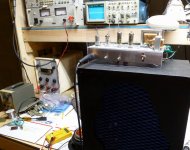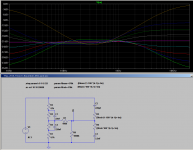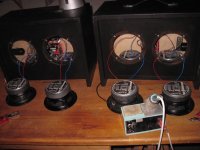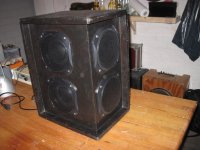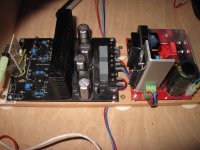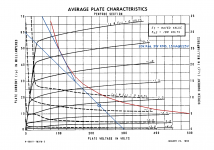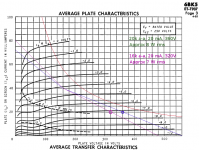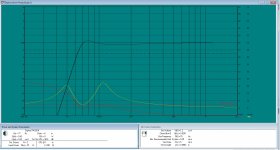Part of the idea is to use a low-pass filter to feed the tweeter, to avoid the problem you described.Tweeter and electric guitar are not compatible, at least to my liking..
A tweeter connected directly to the output of a distorted electric guitar amplifier, would be a very bad idea, I agree with you 100%. It would sound nasty, and maybe damage your hearing. And probably damage the tweeter, too!
The traditional solution (dating from the era of World War II or even a bit earlier) is to use a huge (10" - 15") guitar speaker, which has so much moving mass that it rolls off treble heavily above 5 kHz or so. Even below 5 kHz, but above 1 kHz or so, you get a very directional beam of sound.
So the guitar sounds horribly bright if your ear is on-axis with the speaker, and sounds much duller everywhere else. This is a real problem if you are playing guitar to a room full of people, and not just to yourself...everyone hears a different sound, and some people are being tortured by too much treble.
My idea is to use a tweeter (or midrange) to avoid the excessive beaming - but also add a 5 kHz or so lowpass filter between amp and tweeter. In this way, the tweeter won't put out much above 5 kHz, so it won't sound significantly harsher or louder than the traditional guitar speaker - but the sound will be more uniform over a wider sweet spot.
For acoustic guitar use, the additional lowpass filter could be switched out, to get full-bandwidth response.
I believe you. Most play much too loud, and with far too much treble. I wear earplugs to live music performances, even in restaurants and coffee-shops.most guitar players i know have audition problems,
For myself, I'm now using a guitar amplifier I built, which has only about 2 watts RMS power output. It also includes an L-pad (speaker attenuator) so I can cut down the power even lower. With a 92 dB/W speaker, it is theoretically capable of 95 dB SPL @ 1 metre...enough to damage your hearing. So I never use it at full power.
-Gnobuddy
Thank you for the excellent suggestions! I didn't know there were any cone midranges available with 102 dB/W@1m sensitivity!There are some nice low-midrange 6.5-inch speakers on the market, for instance
18 Sound 6ND410
Monacor SP6-100/PA
The Monacor seems perfect, except too expensive for a budget amp. But I'm still considering using it, if I can't find a less expensive alternative.
These days there are some very affordable little (2" and 3") speakers that are laughably called "full range". They would make good guitar amp tweeters except for one thing - far too little sensitivity!
-Gnobuddy
The pentode can be switched to be either an input stage, or a second amplification stage? Interesting idea!
How are you liking the James tone control? In LTSpice, I found the passive James circuit simulates rather badly (with very assymmetrical boost/cut behaviour), which has discouraged me from building one.
The passive Baxandall seems to have the same problem, i.e. extremely different boost and cut characteristics.
I've recently tried the Fender Bandmaster tone control circuit (from Merlin Blencowe's book), and wasn't thrilled with it, as the controls are quite interactive.
I also tried a modified version of the Voight tone control circuit from Blencowe's book, and liked that one better. The controls interact less, cut and boost are pretty symmetrical, so it's easier to dial in the tone you want. (I posted my version of the circuit earlier in this thread.)
I think an active Baxandall with an LND150 MOSFET would be a little bit of an improvement over the Voight, but it's a lot of additional complexity for a subtle benefit...may not be worth it.
-Gnobuddy
No time to build amps right now so I can't say how the James is. Are you simulating with Log pots?
Yes, and with the usual lopsided capacitor values that go along with the log pots (ten times bigger capacitance on the earth end of the log pot). I also tried other cap values that are intended to produce less insertion loss, for instance, 2x capacitance at the earth end of the pot, and a nominal 6 dB insertion loss.Are you simulating with Log pots?
Either I'm stupidly repeating the same mistake in multiple simulations, or the "log pot plus 10x cap" concept doesn't really work all that well.
When I simulated active versions of the Baxandall or James circuits, they do work properly, though, with the usual very smooth and symmetrical control range.
Some asymmetries in the passive versions of these circuits are easy to spot. For instance, maximum boost (in dB) cannot be greater than the insertion loss (also in dB). If you have 20 dB insertion loss, the maximum boost you can get at any frequency is +20 dB.
But in principle you can cut the signal all the way to zero volts, so maximum cut can can go to minus infinity dB. That makes for very asymmetrical cut and boost curves.
From my simulations, it looks as though the treble and bass corner frequencies also move around - a lot - when the pots are turned. More asymmetrical weirdness.
I'm in a bit of a rush right now, but I'll dig up one of my simulations and post screenshots (or LTSpice files) later, in case anyone else wants to take a look. If I'm making some dumb mistake, perhaps someone else can spot it.
I know our brains are pretty good at coping with a lot of nonlinear things, but I really like tone controls that are dead-simple and totally predictable to use. That way I can save what brain-power I have for actually making music, instead of struggling with the tone controls! So far, the modified Voight circuit comes closest for me, though it isn't perfect, either.
-Gnobuddy
The weirdness in the usual Fender - Marshall - Vox tone stack is real and highly dependent on the source and load impedances.
Try this simple simulator. I have used an older version (during the active build part of this thread) and found it to be pretty close to reality.
TSC
The Baxandall tone circuit was intended for use in HiFi amps. The F-M-V tone stack was created by Fender with their usual goals in mind.....ultimate cheapness. Yes, all three controls interact, and the corners move. Many amps simply copy this because that's what most tube amp players are used to.
You might not need 102 db. If your guitar speaker is around 100 db you might want the midrange a bit quieter since most amps tend to peak in the midrange. The lows tend to be rolled off somewhat to avoid blocking, and to get away with a smaller OPT. Since you are rolling your own, you can make what you want however.
Several years ago I stuffed two cheap Dayton Audio 6 inch "Pro Audio" speakers (PA165-8, 93db, $18) into a ported 1.4 cubic foot box made with thin (1/2 inch) plywood, tuned to 70 Hz. Later I added a cheap Pyramid tweeter crossed with just a cap and an on - off switch. The idea was to make a pair of cheap, lightweight boxes that I could toss around, and abuse with lotsawatts without worrying too much if I blew a speaker. The total cost of all the drivers is like $42 per cabinet.
I have fed both cabinets electric guitar with a tube amp that makes 125 watts clean and over 150 at clip played outdoors, cranked for several hours, and ue these speakers for testing unknown amps. No blown drivers yet.....I fed them with a 100 watt Park 1207 (Marshall super lead 100W) too.
I have also used the same cabinets from a $25 Lepai class D Hifi amp running from a car battery playing a Roland synth (inverter fed from the same battery) for a parking lot (maybe 100 spaces) flea market gig, and the volume was adequate. Several people were surprised at the sound quality from my $100 PA system. The piano sounds from the old Roland JV-1000 were spooky real from those speakers. That's why I put in the tweeter.
Part of one of the cabinets can be seen here with amp 1.4 sitting on top.
Try this simple simulator. I have used an older version (during the active build part of this thread) and found it to be pretty close to reality.
TSC
The Baxandall tone circuit was intended for use in HiFi amps. The F-M-V tone stack was created by Fender with their usual goals in mind.....ultimate cheapness. Yes, all three controls interact, and the corners move. Many amps simply copy this because that's what most tube amp players are used to.
I didn't know there were any cone midranges available with 102 dB/W@1m sensitivity!
You might not need 102 db. If your guitar speaker is around 100 db you might want the midrange a bit quieter since most amps tend to peak in the midrange. The lows tend to be rolled off somewhat to avoid blocking, and to get away with a smaller OPT. Since you are rolling your own, you can make what you want however.
Several years ago I stuffed two cheap Dayton Audio 6 inch "Pro Audio" speakers (PA165-8, 93db, $18) into a ported 1.4 cubic foot box made with thin (1/2 inch) plywood, tuned to 70 Hz. Later I added a cheap Pyramid tweeter crossed with just a cap and an on - off switch. The idea was to make a pair of cheap, lightweight boxes that I could toss around, and abuse with lotsawatts without worrying too much if I blew a speaker. The total cost of all the drivers is like $42 per cabinet.
I have fed both cabinets electric guitar with a tube amp that makes 125 watts clean and over 150 at clip played outdoors, cranked for several hours, and ue these speakers for testing unknown amps. No blown drivers yet.....I fed them with a 100 watt Park 1207 (Marshall super lead 100W) too.
I have also used the same cabinets from a $25 Lepai class D Hifi amp running from a car battery playing a Roland synth (inverter fed from the same battery) for a parking lot (maybe 100 spaces) flea market gig, and the volume was adequate. Several people were surprised at the sound quality from my $100 PA system. The piano sounds from the old Roland JV-1000 were spooky real from those speakers. That's why I put in the tweeter.
Part of one of the cabinets can be seen here with amp 1.4 sitting on top.
Attachments
Just got done with necessary chores, so here's a screenshot of one of my attempts at using LTSpice to simulate a passive James circuit. I'll upload the LTSpice .asc simulation file as well, if the forum software will let me.
Some time ago I found online instructions on simulating a linear pot using LTSpice (two resistors, two algebraic equations, and .param and .step Spice directives.)
From that starting point, after some head-scratching, I worked out the algebraic equations for a logarithmic pot.
If, say, Rpot is the end-to-end value of the pot, R1 the resistance from wiper to ground, and R2 the resistance from wiper to the "hot" end of the pot, these equations simulate the pot:
R1 = Rpot*100^(k-1)
R2 = Rpot*[1-100^(k-1)]
"k" is the parameter that "turns" the pot; when k=0, the pot is at at one end, when k=0.5, the pot is turned through half it's travel, and when k=1, the pot is at the other end.
I believe these equations are correct, as they pass all the logical sanity checks:
In the screenshot, the directive ".step param k 0 1 0.125" turns the pot from one end (k=0) to the other (k=1), in steps of 0.125, which is one-eighth of the total rotation.
That means, if the tone control was linear and precise, you would see nine equally spaced and symmetrically spaced curves on the graph. (k=0 plus the 8 other step values of k.)
But that isn't what I see at all. Instead, there seem to be a host of problems:

(Though not as awful as the usual Fender/ Marshall/ Vox 3-knob atrocity!)
-Gnobuddy
Some time ago I found online instructions on simulating a linear pot using LTSpice (two resistors, two algebraic equations, and .param and .step Spice directives.)
From that starting point, after some head-scratching, I worked out the algebraic equations for a logarithmic pot.
If, say, Rpot is the end-to-end value of the pot, R1 the resistance from wiper to ground, and R2 the resistance from wiper to the "hot" end of the pot, these equations simulate the pot:
R1 = Rpot*100^(k-1)
R2 = Rpot*[1-100^(k-1)]
"k" is the parameter that "turns" the pot; when k=0, the pot is at at one end, when k=0.5, the pot is turned through half it's travel, and when k=1, the pot is at the other end.
I believe these equations are correct, as they pass all the logical sanity checks:
- R1+R2 is always equal to Rpot for any value of k.
- If you set k to 0, then R1 = 0.01*Rpot, and R2 = 0.99*Rpot.
- If you set k to 0.5, then R1 = 0.1*Rpot, and R2 = 0.9*Rpot. This is the usual modern log pot behaviour, with 10% of total resistance when rotated to 50%. (I've read that there were slower-taper log pots available in the past, for example, 30% resistance at 50% rotation.)
- If you set k to 1.0., then R1 = Rpot, and R2 = 0.
In the screenshot, the directive ".step param k 0 1 0.125" turns the pot from one end (k=0) to the other (k=1), in steps of 0.125, which is one-eighth of the total rotation.
That means, if the tone control was linear and precise, you would see nine equally spaced and symmetrically spaced curves on the graph. (k=0 plus the 8 other step values of k.)
But that isn't what I see at all. Instead, there seem to be a host of problems:
- Bass boost is very nonlinear with (log) pot rotation, and pretty wimpy except at full boost.
- Treble boost is also non-uniform in a similar way.
- Bass cut is pretty feeble.
- So is treble cut.
- The frequency response isn't particularly flat at any point, and there is some control interaction.
- The frequency at which treble cut begins is very different from the frequency at which treble boost begins.
(Though not as awful as the usual Fender/ Marshall/ Vox 3-knob atrocity!)
-Gnobuddy
Attachments
I've decided to completely avoid that circuit, unless Murphy's Law shows up, and I find that I cannot get the sound I want using any other tone control circuit.The weirdness in the usual Fender - Marshall - Vox tone stack is real and highly dependent on the source and load impedances.
I've used the Duncan Tone Stack simulator a few times some years ago. This summer, I decided to put some time into getting more familiar with LTSpice, so I've done all my simulating with it. Using LTSpice also gives me a bit more confidence in the simulated results, as it's widely used and well-tested software.
A sad and vicious circle. There were better alternatives around, but they never got popular.Many amps simply copy this because that's what most tube amp players are used to.
An acquaintance had a Dean Markley CD30 (valve) guitar amp; input and output was all-valve, but there were opamps in the middle, including some very nice, very flexible, very powerful active tone controls, which included some useful switches as well as knobs.
It was a nice-sounding, very flexible, very powerful guitar amp, with incredibly beefy power and ouput iron. (The 30 watt rating was probably very, very conservative.)
Unfortunately, hardly anybody has ever heard of a Dean Markley guitar amp. I think the CD30 was introduced in the 1980's, and then re-issued around 2010. I don't think they caught on either time.
I found a few FaitalPro 3" and 4" drivers with nominal 91 dB/W sensitivities at Parts Express. The ceramic-magnet versions are under twenty bucks each. Directivity is not too bad at 5 kHz, certainly a lot better than a typical 12" guitar speaker.You might not need 102 db.
In my DIY guitar amp, I'm using a cheap 8" dual-cone P.A. speaker (GRS 8FR-8), also from Parts Express. The GRS 8" full-range speaker has the same 91 dB@1W@1m rated sensitivity.
Treble response is poor, and rather directional, even with the small secondary "whizzer" cone. Perhaps one of the FaitalPro 3-inch or 4-inch "woofers" would be a good partner "tweeter" for it.
George, you have a habit of having all my good ideas before I have them!Several years ago I stuffed two cheap Dayton Audio 6 inch "Pro Audio" speakers (PA165-8, 93db, $18) into a ported 1.4 cubic foot box made with thin (1/2 inch) plywood, tuned to 70 Hz. Later I added a cheap Pyramid tweeter crossed with just a cap and an on - off switch.
With all the guitar-mojo-mysticism about the need for alnico magnets, seamed cones, and magic paper cones made with 10% manna from heaven, how did the Dayton Audio speakers sound to your ears (when fed with electric guitar, that is)?
And this is another very interesting idea that has been on my mind as well. I go to a couple of weekly music jams with a group of friends. Right now it is summer and absolutely gorgeous outdoors here in British Columbia. So an outdoor jam in a park would be wonderful. The catch is that I usually provide the small P.A. for vocals, there is no AC power in the parks I'm interested in, and I don't have a battery-operated alternative.I have also used the same cabinets from a $25 Lepai class D Hifi amp running from a car battery playing a Roland synth (inverter fed from the same battery) for a parking lot (maybe 100 spaces) flea market gig,
Coincidentally, a 70 Hz lower corner frequency is about what I had decided to go with for a vocals-only small P.A. system. Also coincidentally, I do have a $25 Lepai class-D amp hooked up to my wife's computer! (Probably the same one you have.)
The little Lepai only puts out about 5 watts RMS per channel into an 8 ohm speaker before clipping, despite Parts Express' very optimistic max power specifications. So I never considered it for P.A. duty. But if it worked for you, I better try it out!
-Gnobuddy
5 watts RMS per channel into an 8 ohm speaker
I have two 8 ohm 6 inch speakers per cabinet plus one 8 ohm tweeter crossed over with a cap (don't remember the size, maybe 4uF). That presents a roughly 4 ohm load to the Lepai, for maybe 10 WPC, probably a bit less running from a 12 volt boat (trolling motor) battery. It's plenty loud in a quiet park setting, and was running at about 1/3 volume control setting with the Roland plugged directly into the Lepai. The other players except for the guitar, were using acoustic instruments, violin, mandolin, and banjo. The guitar player had a Roland Cube which ran from AA batteries and maybe made 5 watts cranked.
how did the Dayton Audio speakers sound to your ears
They are not guitar speakers, and do not exhibit the usual midrange honk and cone breakup of a guitar speaker. They are rather clean sounding until really cranked, which was the idea. The simulation promised rather flat response down to 75 Hz, and they sound rather flat, but I never tried to measure them.
There is some obvious port noise and cabinet rattle when played loud on the 6th string. I never realized just how much of the sound (and air) comes through the port even with 6 inch speakers. A thicker box with a better port would be a good idea if you plan to get loud a lot. It's audible with a 20 watt (2 X 6CW5) amp cranked. At about 1/3 throttle the same amp sounds real clean with better sounding clean bass than expected. The amp will clip at about 6 watts into these speakers at 80 Hz because the speakers are about 25 ohms and the amp runs out of voltage (320 volts, 3300 ohm OPT).
I built then for "test" speakers so that I could hear the true sound of the amp, both for MI and HiFi applications, and so that I could play with big power cheaply. I also wanted light weight for outdoor use when needed. I can carry everything I need for outdoors in one trip easily except for the battery. The big battery I have will play all day at full tilt with out going below 12 volts, but it weighs 65 pounds. You can now get LiFePo4 (not LIPO) "lead acid replacements" on Ebay reasonably cheap which would be the power of choice today.
I set up both cabinets and a sweep tube amp outdoors for a friend and let him abuse them for several hours a few years ago for a parking lot "classis rock" gig in a strip mall. My amp was fed from the RCA jack output on his little DSP powered chip amp (Line 6 maybe). I have another cabinet that has two EVM-10M speakers. We tried it first. As expected they were louder (99 db sensitivity) but nobody seems to like their sound. We also had an old Fender cabinet with two unknown 12 inch speakers. The pair of Dayton based cabinets sounded best to all involved, so they were used, both cabinets stacked on top of the bass players cabinet to get them up in the air. There was some noticeable differences in the sound when walking along the pavement behind the audience, but I noticed the same thing from the drums too, so it was the crowd and the concrete, not the speakers.
Unfortunately, that was the only time that I got to hear them cranked, other than in my tiny work room in Florida, which was also not a real good test situation either. They quickly displaced the EV's as my go to test speakers though.
I found a few FaitalPro 3" and 4" drivers with nominal 91 dB/W sensitivities at Parts Express.
I have a small Faital Pro 4FE32 Neodymium "woofer" that I planned to put inside an electric guitar fed by a TI class D chip amp. Unfortunately is sounded pretty bad in the guitar body that I had made at the time. The cavity for the speaker was just too small and porting it only made it sound worse no matter what I stuffed it with.
I did try it in a bigger box, and it sounded pretty good, but it was a bit directional, and it sounded like the speaker might have distorted before the chip amp did. It was still plenty loud for a "boosted electric guitar." The idea was for an electric guitar with effects capable of playing along side acoustic instruments without the need for an amp.
The amp was an evaluation board from TI salvaged from the trash at work. It was rated for 10 watts RMS, but I was feeding it a bit more than the rated voltage from a laptop brick, but never measured the actual power.
I will revisit this idea some time in the future, possibly with a tiny tube amp. It comes from a fuzzy memory from when I was about 12 years old. The local Lafayette Radio Electronics store had an electric guitar with a (germanium) transistor amp and speaker inside. I used to ride my bike to the store just to play it. It sounded real cool (old memories can be deceiving) just as the batteries died.
I had some 3 inch Tang Band "full range" closeouts from PE. I got the idea of making a mini stack with 4 of them. It looked cool at about 10 inches square, but didn't sound all that great, and didn't live long with the 20 watt tube amp behind it.
I also got a pair of Faital Pro 6 FE200's that were on their "open box" page for a good price. I tried them with the 20 watt tube amp to make sure they were good when I got them, but haven't made a good cabinet for them yet. They are more efficient than the Daytons, and eat more power, so should be louder, but cost over twice as much. Only time will tell, real plywood (or pine) this time .
I fiddled with battery powered amps for some time. Checked the 6 inch Monacors but did not like them really for guitar - too much treble for my taste. But they sound amazing with human voice, so I built two active monitors with 4 speakers each, driven by 200W iraud class-d-amp. A Very nice sounding and powerful mini-PA for clubs.
For a small battery guitar setup my favourite is the Jensen MOD-6 /4Ohm, driven by TPA3118 and 12V SLA.
For a small battery guitar setup my favourite is the Jensen MOD-6 /4Ohm, driven by TPA3118 and 12V SLA.
Last edited:
Here are some pictures. As can be seen these cabinets are "bi-directional" - one baffle pointing to the public, the other to the singer. Often saves us a monitoring system.
Attachments
Last edited:
my favourite is the Jensen MOD-6 /4Ohm, driven by TPA3118 and 12V SLA
I have all of those ingredients.......somewhere. I stuffed everything into moving boxes when I had to move on short notice, and haven't seen some of those things in a couple of years, but I haven't really looked for them either......they will turn up, then I will try it.
Good idea!...one baffle pointing to the public, the other to the singer. Often saves us a monitoring system.
Is Vas really tiny for those speakers? Four of them in such a small cab works okay?
I had a similar idea for my DIY guitar cab. I thought about having one small rear-facing speaker (with it's own Lpad to reduce monitor volume). In the end I didn't go ahead for two reasons - I was concerned about needing a bigger cabinet volume, and also I wasn't sure the smaller rear-facing speaker would sound at all similar to the bigger one in front.
Even if the tone isn't matched front and back, it might still be a useful idea. Generations of electric guitarists have stood in front of their guitar amps, with the sound aimed directly at the backs of their ankles. Just about any change has to be an improvement on that!
-Gnobuddy
There's a bird called the Great Argus Pheasant; the male has insanely long wing feathers that drag on the ground, and which make the bird bulky, clumsy, slow, and vulnerable to predators. Unfortunately for the male, the females measure the male's attractiveness by the length of his wing feathers. Evolution has backed the poor male Great Argus Pheasant into a no-win situation. Either he gets eaten early by a predator, or he lives and dies alone and loveless.Hey, put a speaker on the side to get even with a heavy handed drummer
The contemporary drummer is in much the same situation.
Big-band and then rock-n-roll and rock music took those military drums, modified them for more durability - and made them even louder. In the days before sound-reinforcement systems existed, louder was better and sold more drums (just ask John Bonham's ghost.)
And now it's the 21st century, and we cram those super-loud drums into increasingly smaller live music venues, and the loud drums force all the other musicians to be ear-splittingly loud too...
Surely drum evolution, being guided by the human brain, can back-track to saner volume levels? We don't have to be as hopelessly stuck as the male Great Argus Pheasant, do we? We desperately need quieter drums - and drummers sane enough to use them!
Back on topic - a few 6LY8 valves recently found their way into my box of treasures. The triode section seems to be half a 12AX7, judging by the datasheet numbers and curves. The pentode section (my first pass at a push-pull load-line is attached) looks good for around 3W RMS in push-pull. Importantly, this is using the same output transformer (22.5k Raa) and power supply (around 225V B+) I'm using now in my current amp. I have a 10W audio line transformer that would probably work, too.
Lessee. Two triodes could make a long-tailed-pair phase splitter, leaving two pentodes for a push-pull output stage. How about a two-bottle, 3-watt "Super-Lite" version of the 18-watt Marshall power amp? (Plus one more bottle for the preamp.)
A few lost 6BK5's also meowed and followed me home. Those look good for maybe 8 watts RMS in push-pull with around 330V on the anodes. Perhaps that's enough power for a combined acoustic/electric amp, like the Riviera we were discussing a couple of days ago?
Too many interesting ideas, too much perfectionism and Internet time-wasting keeping me from following through with them.
-Gnobuddy
Attachments
I think I made a mistake calculating Raa in the graph above. The slope of the blue load-line is 5k in the class A region (zero to 30 mA anode current), and 2.5k in the class B region (above 30 mA, when the other valve has cut off). I think that means a 10k Raa transformer, not a 20k one as I indicated on the plot.
That's a good thing, less primary inductance needed for the same bass response. Maybe a cheap 70V audio line transformer will do.
-Gnobuddy
That's a good thing, less primary inductance needed for the same bass response. Maybe a cheap 70V audio line transformer will do.
-Gnobuddy
I just have to stop myself from trying to go in five different directions at once, and slow down long enough to actually accomplish something.I think the 6BK5 would make a cool amp. Hope you go for it.
For fun, here's my first pass at some push-pull load lines for a pair of 6BK5 valves. This time it really is 16k to 20k Raa for the output transformer, dictated by the higher B+.
B+ (in the ballpark of around 320V - 360V) was chosen partly with the idea of using a Triad N68-X as a power transformer (turned backwards and wired to double the 115V mains voltage). Or a voltage doubler, with the transformer run 1:1 as designed.
If we trust the datasheet, and I run the screen grids at 250V, it looks like it will only need around (- 8) volts on the control grids to bias it. So a 12V switch-mode power supply might provide enough bias voltage to do a fixed bias output stage, as well as powering the heaters (wired in series).
That's the output stage. That's about as far as my initial thoughts on this one went.
Since I heard about that Rivera two-in-one amp, I really like the idea of one (valve) amp for both acoustic and electric guitar, and maybe that's the direction to take.
So, what to do for the phase splitter? If this is to double as an acoustic guitar amp, I guess we want a low-distortion PI, so that means cathodyne (or MOSFET "sourceodyne"). No long-tailed pair need apply (unless we add unbypassed cathode resistors to linearize the differential amp.) 6BK5's don't need much drive voltage anyway, so cathodyne/sourceodyne is probably the way to go.
I think 360V is too high for the LND-150 (too much power dissipation for the tiny TO-92 package, even at 1 mA drain current). So either the traditional half 12AX7 cathodyne, or some other MOSFET in a bigger package for the sourceodyne.
I'm not sure yet what route to take with the acoustic guitar channel. If I get the power amp and speaker/enclosure to be reasonably low distortion and flat frequency response, hopefully the (clean) preamp will be easy to design. Maybe use the clean, flat-response PA 6" speakers George suggested. If they get down to 80 Hz, the acoustic guitar range is covered.
If the power amp is clean, and the speaker is flat, then all audible tube distortion on the electric guitar channel must come from the preamp. From my current project, I think I can get that from a 6JW8 (or maybe one and a half of them).
How about adding a little EQ circuit in the drive channel preamp to create a honky midrange peak to make the (flat) PA speakers sound like (midrange heavy) electric guitar speakers. Would that work?
The acoustic guitar channel wouldn't have the midrange peak EQ built into the preamp, so it would be flat, and suitable for acoustic guitar (or vocals, keyboards, etc).
I may have just over-complicated this project idea to the point where it will be still-born. Perhaps this time I should go against my instincts, and just roughly follow the schematic of a Fender Deluxe (the '65 reissue, not the older tweed versions), except for the 6BK5 output tubes. That way there will be very little R&D involved, just a fairly straightforward build.
But I'm really tempted by the acoustic+electric amp concept!
-Gnobuddy
Attachments
I just have to stop myself from trying to go in five different directions at once, and slow down long enough to actually accomplish something.......I may have just over-complicated this project idea to the point where it will be still-born.
I know that feeling because I have the same affliction. About 2 years ago I had only a 3 X 3 foot table for a work area so I decided to start building an analog music synthesizer since I have wanted to make one since the 70's, and it was small enough to fit my work space. Well, that project has changed directions several times and I currently have 6 or 7 breadboards and experiments going with nothing close to a finished musical instrument......
I forced myself to finish Amp 1.5 since it was the closest thing I had to a completed project. It now has a proper chassis, but still doesn't have a wooden box yet. It is however a useful amp without a box and I don't have to worry about touching the electricity with one hand while holding the guitar in the other.....yes I reached over to turn it up and grabbed something hot when it was just a PC board and two transformers sitting on the bench. Won't do that again.
Both versions of Amp 2.whatever have now been found, well the boards at least. Still don't have the transformers, so one of them will probably be my next guitar amp.....unless......I get another wild idea......I keep dreaming of a morphing amp.
About 20 years ago I bought a dual personality guitar amp at a flea market. It was a tube amp made by the Audio Crafters Guild in the late 60's. There was a single preamp with reverb feeding an "Ultraflex" knob which blended the preamp output into one or both of two different power amps, each with its own speaker. Both power amps used 7591's but different parts values and OPT's were used in each amp. The amp with the small OPT fed a 6 or 8 inch speaker, and the bigger amp fed a 12 inch speaker. With the Ultraflex knob wound all the way towards the big speaker you got a clean tone with minimal distortion unless you used a fuzz pedal. Dialing in a bit of the small speaker and a whole lot of reverb, put you on the beach surfing in 1960's California. About a 50 / 50 mix, an ES-335 and just enough volume to initiate distortion called up BB King. Turn the knob to the right, crank all the knobs, plug in my Vox Tome Bender clone (germanium fuzz box) and you can hear Jimi. Sadly I gave the amp away when I left Florida because it was too big and heavy to move.....but someday I will make another, but better, whatever that is.
So, I hate to bring up direction #6, but the single preamp - split - dual power amp with separate speakers sounds like a possibility. The Parts Express speaker is clean, at least at any volume level playable in a small room. One clean amp feeding the clean speaker, one "guitar" amp feeding a guitar speaker, a knob to dial up how much of each you want. You would need to put two speakers in a box with a partition between them. If you used 6 inch speakers the box wouldn't be any bigger than the dual Dayton cabinets that I have now.
The speaker in most acoustic amps is not flat. I has a tone meant to accentuate the higher frequencies. Several years ago Peavey bought Trace Elliot and must have made some changes since the speakers used in these amps showed up at Parts Express cheap. I got some and tried them is several different cabinets, and couldn't find much use for them, but I don't play an amplified acoustic guitar.
Trace Elliot
Here is the output from the simulation that I used to make the box for the Dayton speakers. My box is 1.2 cu foot with two of the Dayton drivers in it. I decided that I would live with 1 db of ripple in order to get the corner down to 70 Hz. A smaller 0.9 cu Ft box with a similar sized pore sims to perfectly flat with the corner at 80 Hz.
Attachments
- Home
- Live Sound
- Instruments and Amps
- The Hundred-Buck Amp Challenge
